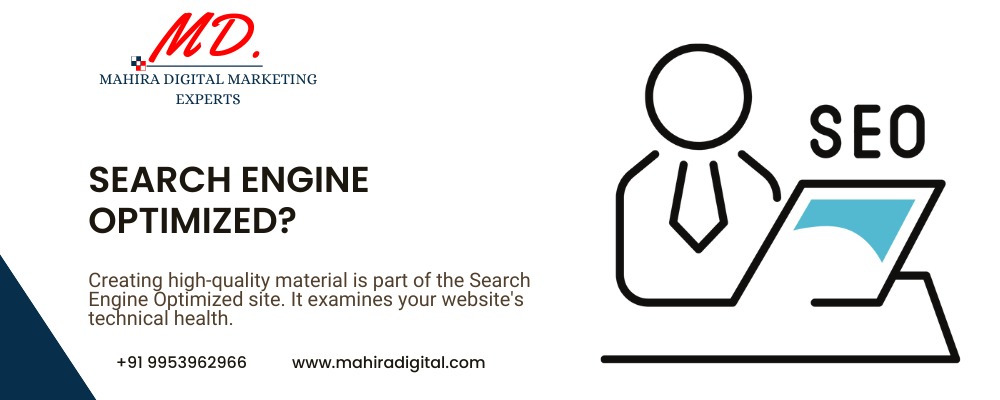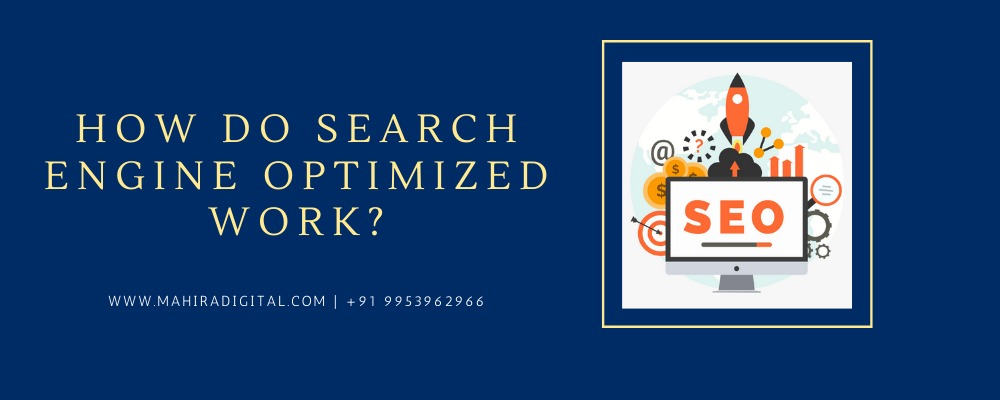
Table of Contents
Search Engine Optimized
Search engine optimization (SEO) uses search engines such as Google, Bing, and others to boost your website’s organic traffic and ranking. Creating high-quality material is part of the Search Engine Optimized site. It examines your website’s technical health.
How does search engine optimized work?

The Search Engine Optimized algorithm considers several factors to determine the page rank. Most of them are keywords contained in your content. And the search traffic should be good (e.g., enough people to write relevant pages (ask Google). You can use tools such as the Keyword Clearing Tool and Keyword Summary to find keywords that match your strategy. Keep in mind that keyword reuse in your work is an old practice that will not help you get better rankings on Google. Instead, use keywords to focus on the content you create.
Why is Search Engine Optimized site important for business?
So search engine optimized is “free” delivery to your website when you produce a quality page that answers your questions.
Search Engine Optimized techniques used for Search Engine Optimized sites with example
Search engine optimization (SEO) is a technique and practice that encourages search engines to recommend content to users as a good solution. Googlebot collects data from your site and adds this information to Google’s index. A typical SERP starts with a price result that returns typical sales. (Use based on page quality)
How does it work?
SEO works by optimizing the content of your website, searching for keywords, and getting inbound links. Of course, when a browser displays a website, the SERP can return the right results. But it can take months to understand your SEO practice fully.
What is your Search Engine Optimized strategy?

A Search Engine Optimized strategy is a thorough plan for attracting more visitors to your website by using a successful SEO search engine and a keyword strategy.
Three key components of a successful SEO campaign
Your site’s technical settings, content, and links all need to be improved to boost your ranking factor.
1. Technical structure
Three things need to happen to rank your site:
First, search engines need to find web pages online.
Finally, add it to the index. The index is a database of all online content. In this way, the algorithm can search the site for related search queries.
Websites look different to you and search engines. They appear as a collection of graphics, colors, rich text, and links.
As a result, items that cannot be displayed in this way will still not be visible to search engines. As a result, your site will look good, but Google may not be able to access your content.
A few things to remember:
Pages are text only. The browser is well designed. But it only shows text and links.
• If the image contains keywords that rank the page, the image will not appear in the search engines.
The main factors influencing this are:
Site navigation and links
The links are as follows to analyze, but you cannot see the picture. Then set the navigation and links to text only.
Simple URL structure
It’s a complex structure, so shorten the URL if possible. Please set it to include as few non-premium keywords as possible to optimize your pages.
Page speed
Search engines need time to load. When a user wants to read a page as a measure of quality, many elements of your website can affect the loading speed.
Sitemap and Robots.txt file
Search engines use this to determine which pages to search and index. On the other hand, the robots.txt file tells search engines which content you do not want indexed (for example, certain policy pages that you might want to index). Designed to speed up the construction and indexing of content.
Duplicate content
If a search engine finds your site, you could be penalized. For this reason, search engines treat duplicate content as a negative factor.
2. Content
Every time you use a browser, How do you search for content such as information on a specific topic or issue? It can be text for a blog post, website, etc. It could be a video.
There are reasons:
First and foremost, content is what customers are looking for while searching. The only thing they wanted was the goods they gave them.
Here’s an idea of how the page interacts with the search query. When updating the page, You decide on a title. Analyzing things like page length and page layout can help you assess the quality of a page.
Content optimization starts with keyword research.
Search for keywords
what you want to sell, and you want to attract potential customers who then become customers.
However, this only happens if you set the keywords these users will use to search. Otherwise, they are unlikely to find you.
So the SEO process starts with finding words that potential customers can enter into the search engines.
This process usually involves defining work-related terms and topics. Then translate them into keywords. Finally, do a thorough search to find the right words that your viewers can use.
Page optimization
On-page optimization is also known as on-page SEO, and search engines understand page titles and keywords. Be consistent with due diligence.
Note that use of “page” instead of content, as most Search Engine Optimized work on the page focuses on the terminology used. But it extends to optimizing other parts of the code.
You may have heard of some of these names – Meta tags such as title and description are the most common.
On-Page Search Engine Optimized Strategy Guide
a) Keyword optimization
First, double-check that Google recognizes the terms you wish to rank for on this page. It would be best if you contained at least the following keywords to achieve this goal:
URL: The page URL must contain keywords. It’s good without including anything. It also removes all stop words.
H1 Icon: This icon displays the page title by default in most CMS.
Top 100 words (or the first paragraph): Searching for a keyword from the beginning of a blog post ensures that Google is updated.
Title Meta Tag and Meta Tag: These two code components are used by search engines to display the list. The meta heading shows the search list’s title, and the meta description provides the next short slogan’s text. Additionally, both commands should be used to understand the page’s content better.
Image file names and ALT tags: Are you familiar with how search engines display images on your pages? Only the names of their files are visible to them.
On the other hand, the Alt icon is the text that is displayed in the browser instead of an image (visually impaired). However, the image icon contains an ALT tag so search engines will use it as a linked tag.
Include semantic keywords as well (keyword variations or synonyms). Consider what happens if Google discovers sugar, orchard, or apple juice on your page. Right after you choose a question to sort, you’ll know.
That’s what the name does. Added to prevent invalid searches from appearing on pages.
b) Optimization factors that are not related to the keywords on the page
The following sections can also help you verify the authenticity and permissions of your site.
External links: Links to other linked sites will help Google make further decisions on this topic.
Internal links: These links help you improve your position in two ways. First, let search engines find and search for other pages on your site. The second shows the semantic relationships between multiple pages, helping you better determine their relevance to a search query.
Content-Length: In general, the higher the content, the higher the score. This is because if a long blog post is made correctly, it will always contain more detailed information on the topic and will keep the page length for the readers.
Multimedia: set the page quality with multimedia elements, such as video, graphics, and audio players, even if it is not required. And right now, the content seems important and worth the effort.
C) Communication
From what you read in this guide, you can see that no page is ranked without relevance and authority.
To give users the most accurate answer, Google and other search engines prefer sites that seem most relevant and popular to your queries.
The first two areas, technical regulations and content focus on improving relevance (although some of these elements also help emphasize control). But backlinks are a popular resource.
3. Links
A link, also known as a backlink, points to another site’s content. Occasionally, another website mentions your content and shows it to readers. In addition, the reader can look up other statistics. Web admins are more likely to mention high-quality and popular websites than regular ones.
Value Point compatibility
Weak or questionable links that seem deliberately designed to increase the site’s credibility. It may lower your score. So when we create links, Search Engine Optimized is not focused on link building.
The convenience of Internet links
Links from domains that are considered credible by search engines are determined by high quality. That is, compounds of identical target components work well.
Value
Links from domains with similar topics are worth more than links from random sites.
Domain Trust
How reputable search engines will measure the credibility of a website. Communication from credible sources tends to have positive effects on estimates.
Link building
In Search Engine Optimized, the process of acquiring new backlinks is called link building. And as most experts agree, it can be a valuable service.
Building a successful relationship requires creativity. Strategic thinking and perseverance lead to positive relationships. A relationship structure should be developed. This is not a small thing.
A deliberately designed search engine can be unpredictable.
Here are some ways to do it (Search Engine Optimized).
• General Editorial Links – These backlinks are links to the same content. You can enter an address.
• Guest Posts – Guest posts are blog posts from third-party websites. These companies often allow writers and content bios to include a link or two on their sites. • Competition Analysis – Finally, many Search Engine Optimized processes continue to analyze a competitor’s backlink to see what can be reproduced on your site.
